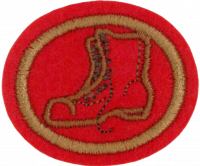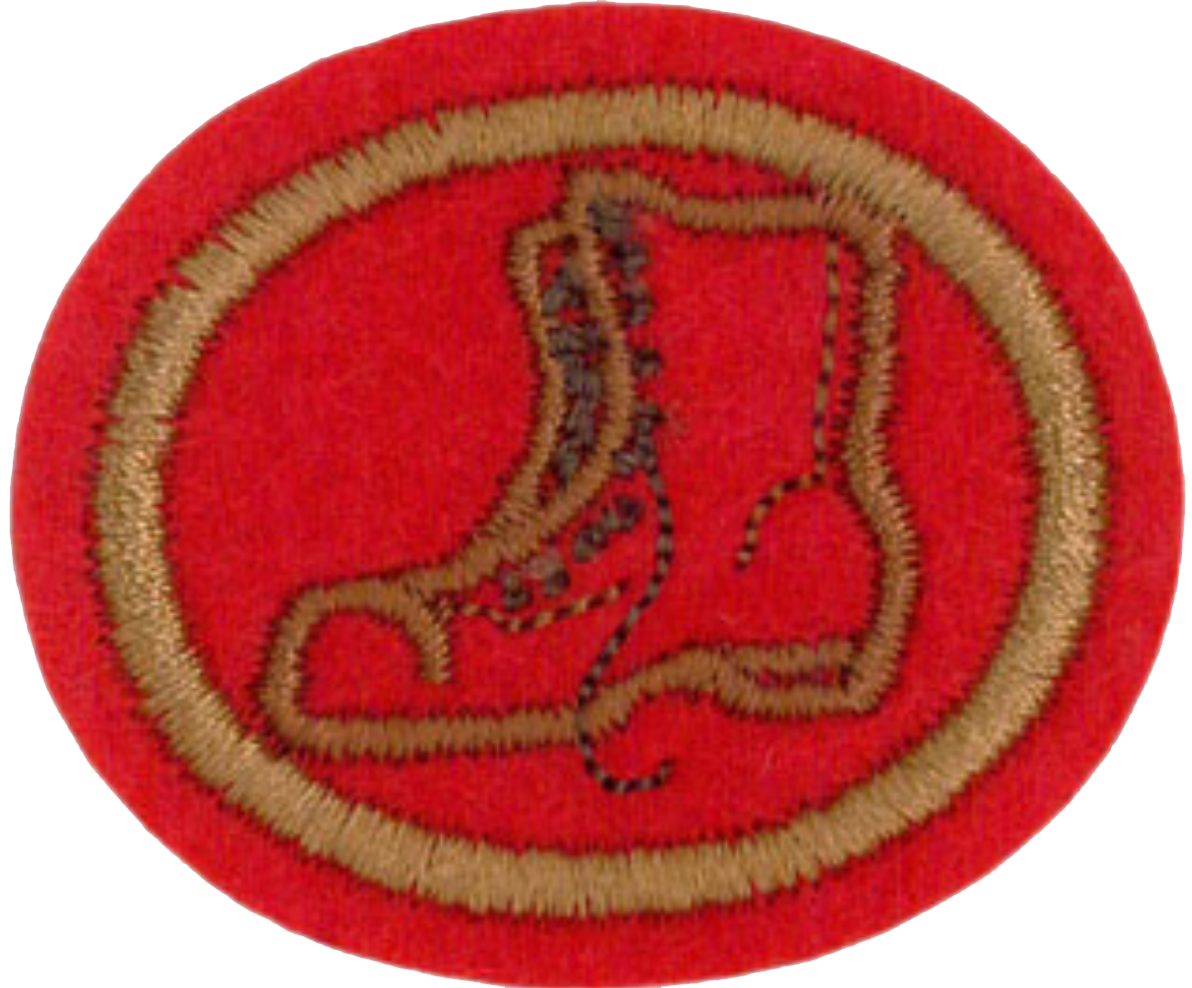Especialidades JA/Reparación de calzado/Respuestas
Nivel de destreza
3
Año
1928
Version
22.12.2025
Autoridad de aprobación
Asociación General
1
Outsole
The outsole is the layer in direct contact with the ground. The material of the outsole varies depending on the function, dressiness, and quality of the shoe, but is generally very durable material, since it experiences the most stress. Dressier shoes have leather outsoles; casual or work-oriented shoes have outsoles made of natural rubber or a synthetic imitation. The outsole may comprise a single piece, or may comprise separate pieces of different materials. Often the heel of the sole is rubber for durability and traction, while the front is leather for style. Specialized shoes will often have distinct modifications on this design: athletic cleats have spikes embedded in the outsole to grip the ground.
Heel
Some shoes have a distinctive raised heel; often this is a separate piece from the outsole and can be replaced. Leather was used in the past, and is still used in some performance tennis shoes, but harder materials are usually more desirable. Plastic, rubber, or polymer materials are now also used. Fortified cork is sometimes used in heels or soles so the shoes are lightweight.
Vamp, or upper
Any shoe also has an upper part that separates the foot from the air, and helps hold the shoe onto the foot. In the simplest cases, such as sandals or flip flops, this may be nothing more than a few straps for holding the sole in place under the foot. Closed footwear, such as boots, sneakers and most men's shoes, will usually have a more complex upper.
Laces
A shoelace is a long piece of string or cord that hold a shoe closed. Usually it is attached by being threaded through a series of small holes in the shoe, called eyelets. To aid this, many shoelaces are tipped with small solid plastic bits called aglets.
Tongue
In some shoes and boots the tongue is a flap-like, usually flexible, part that goes underneath the laces.
2
Because the stitching of the outsole is done completely on the outside of the shoe, this type of sole is easiest to repair.
McKay sewed soles
Ten years after the invention of the sewing machine, Gordon McKay introduced a device for machine-stitching a shoe's upper to its sole. In this type of sole, the insole is attached to the upper while it is still on the last using tacks which are clinched over. The outsole is then sewn to the assembly by McKay's machine. The stitching appears on the inside of the shoe, as do the tacks. This type of construction was common for cheap, lightweight shoes.
Curved Needle Machine
The outsole is attached to the upper with a welt. The curve needle machine allows the soles to be stitched through the Goodyear welt without the going through the upper so the shoes can be resoled many times without sewing through the uppers.
3
4
5
6
7
You should have your feet measured every time you buy shoes if they are still growing. Even when they stop growing, it's still a good idea to have them measured occasionally, as their shape may change. There are two parameters that specify the shoe size: length, and width.
Length
Shoe size in the United States and Canada is based on the length of the last, measured in inches, multiplied by 3 and minus a constant. This constant differs for shoes intended for men, women and children.
Women's sizes are almost always determined with the "common" scale, in which women's sizes are equal to men's sizes plus 1.5 (for example, a men's 10.5 is a women's 12).
In the less popular scale, known as the "standard" or "FIA" (Footwear Industries of America) scale, women's sizes are men's sizes plus 1 (so a men's 10.5 is a women's 11.5).
- [math]\displaystyle{ \mbox{female shoe size (common)} = 3*\mbox{last length}-20.5 }[/math]
- [math]\displaystyle{ \mbox{female shoe size (FIA)} = 3*\mbox{last length}-21 }[/math]
Children's sizes are equal to men's sizes plus 12.33. Thus girls' and boys' sizes do not differ, even though men's and women's do.
- [math]\displaystyle{ \mbox{child shoe size} = 3*\mbox{last length}-9.67 }[/math]
For the international market, the ISO 9407 standard is used for specifying shoe length.
Width
Some manufacturers offer shoes of different width for the same foot length. Such shoes are then also labelled according to the width or girth of the widest part of the foot (typically measured directly behind the toes with the subject standing on both feet and wearing socks or hose).
In the Mondopoint system, the shoe size label can state in addition to the length also the width of the mean foot for which the shoe is suitable, both measured in millimetres.
A number of other ad-hoc notations for width or girth are also used. Examples include (each starting with the narrowest width):
- AAAA, AAA, AA, A, B, C, D, E, EE, EEE, EEEE
- 4A, 3A, 2A, A, B, C, D, E, 2E, 3E, 4E
- N, R, W
None of these designations are formally standardized. The exact foot width for which these sizes are suitable can vary significantly between manufacturers. The A-E width indicators used by some US and UK shoe manufacturers are typically based on the width of the foot, and common step sizes are 1/4 inch (6 mm) or 3/16 inch (5 mm).
Function
The next consideration when selecting a shoe is the activity to be performed when wearing the shoe. You would not wear high heels on a backpacking trip, nor would you wear flip-flops to a wedding. Different shoes have different purposes, though thankfully, some are multi-purpose. Here is a list of some of the types of shoes available:
- Dress shoes
- Casual shoes
- Athletic shoes
- Running shoes
- Hiking boots
- Climbing shoes
- Paddling shoes
- Work boots
- Steel-toed boots
- Snow boots
- Golf shoes
- Bowling shoes
- Slippers
Quality
If your feet have stopped growing, it makes sense to buy the best quality shoes that you can afford. High quality shoes will not only last longer than cheap ones, they are less expensive in the long run because they will not have to be replaced as often. A low-quality shoe can also make your feet sore or even cause injury by not providing proper arch or ankle support.
If you are buying shoes for a person who is growing quickly, you should still seek a quality shoe, but at this point the goal is match the expected lifetime of the shoe to the amount of time it will fit.
Cost
Cost is also a very important consideration. Some shoes are very expensive, not because of their high quality, but because of the name attached to them. Though high quality shoes are usually more expensive than low-quality shoes, this does not mean that all high-priced shoes are also high-quality.
Moral considerations
In the late 1990's several shoe manufacturers found themselves embroiled in controversy after it was revealed that they were exploiting sweatshop labor in third-world countries. There are many people who boycott various corporations because of such practices, and there are many people who patronize companies that commit themselves to respecting human rights.
8
Shoe repair shops are often family-owned businesses, so the chances of speaking to the owner when you enter the store (or call on the phone) are pretty good. It would be better to approach the owner in person rather than calling, as that gives you a better opportunity to present yourself. Wear a class A uniform when you go there to ask permission to observe, and be ready to explain how many Pathfinders will be with you. Let the store owner select a time and date for the five-hour visit. The store owner may also be willing to instruct this honor, so it would be a good idea to make contact before you get started.
Your visit to the work shop will be a good opportunity to meet requirements 3, 4, and 5, but you should probably bring some shoes that need these repairs with you. The owner will certainly not want you experimenting on his customer's shoes! Offer to pay for any materials you use when repairing your shoes.
9


